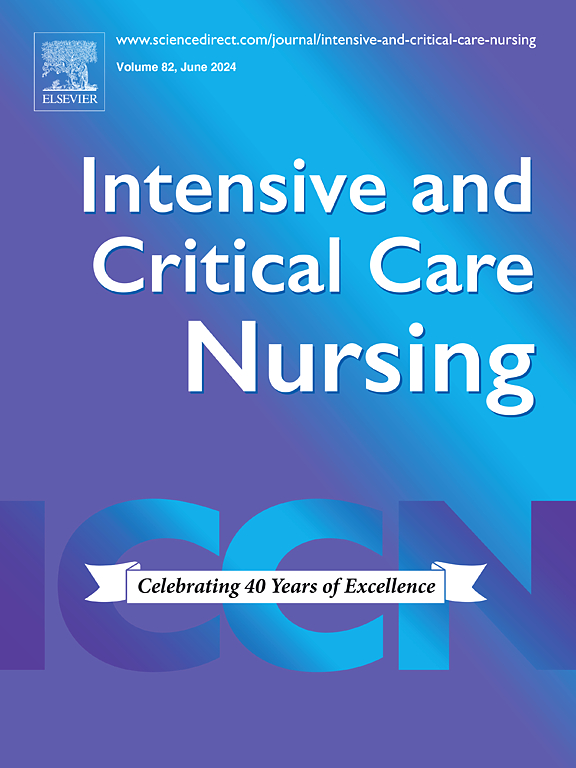The visitors’ book as a family-centered care tool: A corpus-based, multi-site study on the implementation of a narrative care practice in ICU
IF 4.7
2区 医学
Q1 NURSING
引用次数: 0
Abstract
Objectives
Hospitalization in an Intensive Care Unit (ICU) is a profound disruption of the taken-for-granted flow of everyday life, for both the patient and their relatives. While narrative-based tools to address the patients’ traumatic experience in the ICU have been implemented and analyzed, research fails to address ways of dealing with the relatives’ experience in order to align with the Patient & Family-Centered Care framework. This study aims to preliminarily observe the narrative-based care practice implemented in three Italian ICUs by means of a visitors’ book (VB).
Design
Qualitative study.
Methods
Thematic analysis of a corpus of naturally gathered texts written by inpatients’ relatives in the VB.
Results
The semantic analysis, i.e., what relatives write about or refer to in their texts, suggests that the VB is interpreted by users mainly as a way to 1) establish a state of intersubjectivity with the staff, 2) talk into being the disruption they lived as a consequence of ICU hospitalization of a family member, and 3) transform it into an object of thought. The prevalence of references to visitors’ experience indexes the users’ appropriation of the VB as a family-centered care tool.
Conclusions
The VB demonstrably works as a communicative and relational tool, a reflexivity-enabling device enacting and displaying the ward’s orientation toward patient and family-centered care.
Implications for Clinical Practice
Overcoming the limitations of family-centered care relying only on the staff’s individual competences, attitudes, value-orientation, and time constraints, implementing the VB appears to be a sustainable way for the ward to respond to family members’ needs.
访客书作为以家庭为中心的护理工具:基于语料库的ICU叙事护理实践实施的多地点研究
对患者及其亲属来说,在重症监护病房(ICU)住院是对习以为常的日常生活流程的深刻破坏。虽然已经实施和分析了以叙事为基础的工具来处理患者在ICU的创伤经历,但研究未能解决处理亲属经历的方法,以与患者保持一致。以家庭为中心的护理框架。本研究旨在通过访客记录本(VB)对意大利三家icu的叙事性护理实践进行初步观察。DesignQualitative研究。方法对自然收集的住院病人家属在VB中撰写的文本进行主题分析。结果语义分析(即亲属在其文本中写了什么或提到什么)表明,用户主要将VB解释为1)与工作人员建立主体间性状态,2)将其视为家庭成员住院ICU导致他们生活中断的结果,3)将其转化为思想对象。游客体验参考的流行程度表明用户对VB作为以家庭为中心的护理工具的挪用。结论:VB作为一种沟通和关系工具,是一种使反射性成为可能的装置,它制定并显示了病房以病人和家庭为中心的护理方向。对临床实践的启示克服了以家庭为中心的护理仅依赖于工作人员的个人能力、态度、价值取向和时间限制的局限性,实施VB似乎是病房响应家庭成员需求的可持续方式。
本文章由计算机程序翻译,如有差异,请以英文原文为准。
求助全文
约1分钟内获得全文
求助全文
来源期刊

Intensive and Critical Care Nursing
NURSING-
CiteScore
6.30
自引率
15.10%
发文量
144
审稿时长
57 days
期刊介绍:
The aims of Intensive and Critical Care Nursing are to promote excellence of care of critically ill patients by specialist nurses and their professional colleagues; to provide an international and interdisciplinary forum for the publication, dissemination and exchange of research findings, experience and ideas; to develop and enhance the knowledge, skills, attitudes and creative thinking essential to good critical care nursing practice. The journal publishes reviews, updates and feature articles in addition to original papers and significant preliminary communications. Articles may deal with any part of practice including relevant clinical, research, educational, psychological and technological aspects.
 求助内容:
求助内容: 应助结果提醒方式:
应助结果提醒方式:


